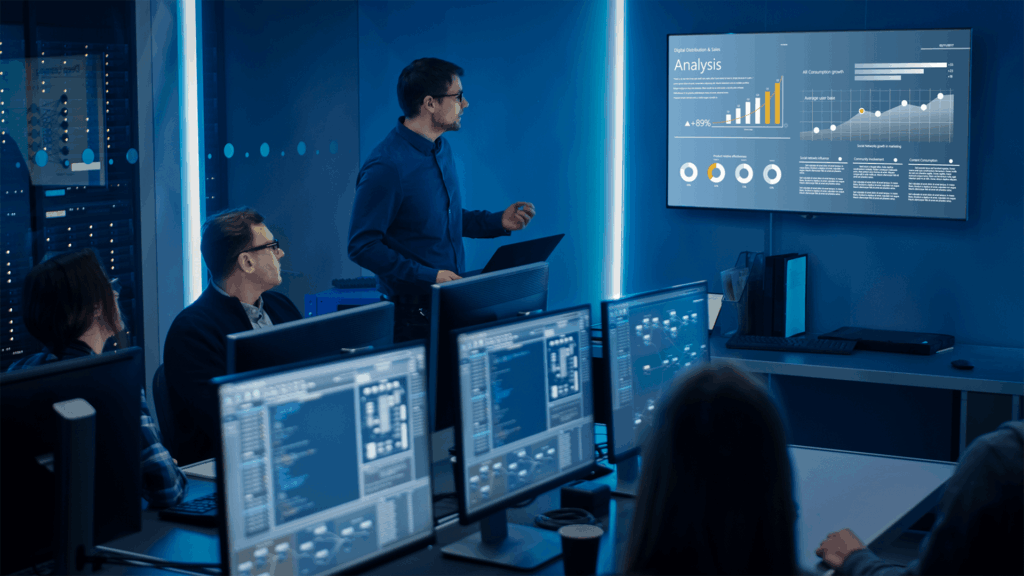Data centers big and small face constant changes to technology and if they don’t keep up, they risk slowing or even shutting down their operations. This could be disastrous for any high-tech facility, which is why data center managers must be aware of evolving technology so they can upgrade on their terms. And as we near the end of 2025, let’s not forget all the advancements data centers have seen this year that require your attention. From the rapid deployment of the AI chip to the widespread adoption of liquid cooling and edge computing, there are countless new ways to improve data center performance and efficiency. Continue reading to learn more about how AI chips, liquid cooling, edge computing, and hyperscale data centers are changing the industry and how you can stay ahead of it all.
AI Energy Use and Sustainability Efforts
According to the 2024 United States Data Center Energy Usage Report, AI servers using GPUs went from consuming 2 TWh of energy in 2017 to over 40 TWh in 2023. AI isn’t going away anytime soon and will only continue to grow, needing more energy to do so. Not only do these AI chips require more power than standard chips to operate, but they also produce more heat in doing so. This means strong cooling solutions are an absolute must when it comes to preventing AI chips from overheating. As a result, AI energy usage raises costs in multiple areas of their data center since they require new cooling equipment as well as the energy to keep them running all the time. Not only is this expensive, but it can also have massive impacts on the environment.
Many data centers rely on electricity from power grids, which typically use fossil fuels to generate electricity. As AI chips require more and more power, these resources increase greenhouse gas emissions which threaten the environment. To combat this issue, many data centers are now implementing wind and solar resources to power their operations and using natural refrigerants to keep things cool.
AI Chips Need Liquid Cooling
The high energy consumption of AI chips doesn’t just affect the global environment; it can also put your data center environment at risk. These chips generate large amounts of heat that need to be dissipated quickly to prevent overheating. However, traditional air cooling is proving to be an inefficient method to maintain the temperatures of AI chips.
Luckily, there is a solution that has become more accessible in 2025: liquid cooling. Instead of relying on circulating air that struggles to dissipate heat, liquid cooling absorbs the excess heat directly from the AI chip and any other equipment it’s connected to. Liquid cooling solutions like the Vertiv™ CoolChip CDU 600 can also be placed in-rack, at end of row, or at your data center’s perimeter to stop any overheating at the source.
Increase in Edge Computing
The need for instant data processing has never been greater as businesses require immediate access to data so they can carry out their daily operations. This has put a great deal of pressure on data centers to find ways to increase the processing speed of cloud computing where the connected equipment may not be in the same location. Edge computing on the other hand presents a viable solution that is becoming widely used in facilities both large and small. Instead of waiting on technology in different locations to process important data, edge computing stores and processes data close to its original source. This increases data processing speed, which decreases response time and the need for additional bandwidth and cloud storage.
The Rise of Hyperscale Data Centers
As AI continues to grow, more data centers are integrating AI deployments on-site. This will require high-density environments and equally powerful solutions. Large companies like Amazon and Google are continuing to grow their AI chip usage, requiring massive facilities known as hyperscale data centers to keep up. In fact, according to the Synergy Research Group, hyperscale facilities account for 44% of all data centers worldwide. This is due to the rise of AI and technology use overall, which requires a great deal of data storage. To accommodate this need, hyperscale data centers can take up hundreds of acres in spite of space saving server organization techniques. These facilities also require large amounts of power to operate and use energy efficient solutions like lithium-ion batteries to keep everything running smoothly. While not every facility needs to be a hyperscale one, the rise of these kinds of data centers underscored the need for stronger solutions to keep up with evolving technology.
Stay Up to Date on the Latest Data Center Trends
Technology is advancing faster than ever before and requires the latest data center equipment to keep it powered and cool. Utilizing liquid cooling, energy efficient power solutions, and edge computing are just a few of the ways data centers can stay modern and healthy. If you’re ready to learn more about how to optimize your facility, sign up for our newsletter to receive all the latest news on the current best practices and equipment.

